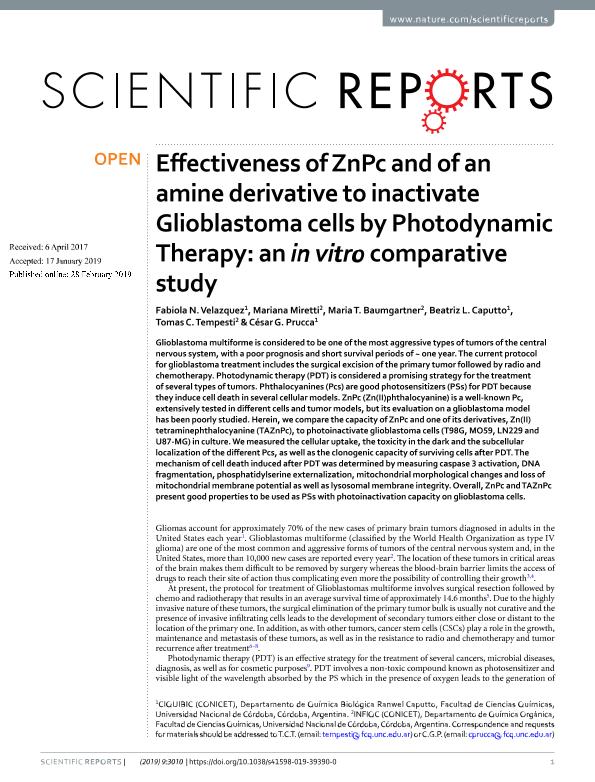Artículo
Effectiveness of ZnPc and of an amine derivative to inactivate Glioblastoma cells by Photodynamic Therapy: An in vitro comparative study
Velazquez, Fabiola Noelia ; Miretti, Mariana
; Miretti, Mariana ; Baumgartner, Maria Teresa del V.
; Baumgartner, Maria Teresa del V. ; Caputto, Beatriz Leonor
; Caputto, Beatriz Leonor ; Tempesti, Tomas Cristian
; Tempesti, Tomas Cristian ; Prucca, César G.
; Prucca, César G.
 ; Miretti, Mariana
; Miretti, Mariana ; Baumgartner, Maria Teresa del V.
; Baumgartner, Maria Teresa del V. ; Caputto, Beatriz Leonor
; Caputto, Beatriz Leonor ; Tempesti, Tomas Cristian
; Tempesti, Tomas Cristian ; Prucca, César G.
; Prucca, César G.
Fecha de publicación:
12/2019
Editorial:
Nature Publishing Group
Revista:
Scientific Reports
e-ISSN:
2045-2322
Idioma:
Inglés
Tipo de recurso:
Artículo publicado
Clasificación temática:
Resumen
Glioblastoma multiforme is considered to be one of the most aggressive types of tumors of the central nervous system, with a poor prognosis and short survival periods of ~ one year. The current protocol for glioblastoma treatment includes the surgical excision of the primary tumor followed by radio and chemotherapy. Photodynamic therapy (PDT) is considered a promising strategy for the treatment of several types of tumors. Phthalocyanines (Pcs) are good photosensitizers (PSs) for PDT because they induce cell death in several cellular models. ZnPc (Zn(II)phthalocyanine) is a well-known Pc, extensively tested in different cells and tumor models, but its evaluation on a glioblastoma model has been poorly studied. Herein, we compare the capacity of ZnPc and one of its derivatives, Zn(II)tetraminephthalocyanine (TAZnPc), to photoinactivate glioblastoma cells (T98G, MO59, LN229 and U87-MG) in culture. We measured the cellular uptake, the toxicity in the dark and the subcellular localization of the different Pcs, as well as the clonogenic capacity of surviving cells after PDT. The mechanism of cell death induced after PDT was determined by measuring caspase 3 activation, DNA fragmentation, phosphatidylserine externalization, mitochondrial morphological changes and loss of mitochondrial membrane potential as well as lysosomal membrane integrity. Overall, ZnPc and TAZnPc present good properties to be used as PSs with photoinactivation capacity on glioblastoma cells.
Palabras clave:
Glioblastoma
,
Photodynamic therapy
,
Zn phthalocyanines
Archivos asociados
Licencia
Identificadores
Colecciones
Articulos(INFIQC)
Articulos de INST.DE INVESTIGACIONES EN FISICO- QUIMICA DE CORDOBA
Articulos de INST.DE INVESTIGACIONES EN FISICO- QUIMICA DE CORDOBA
Citación
Velazquez, Fabiola Noelia; Miretti, Mariana; Baumgartner, Maria Teresa del V.; Caputto, Beatriz Leonor; Tempesti, Tomas Cristian; et al.; Effectiveness of ZnPc and of an amine derivative to inactivate Glioblastoma cells by Photodynamic Therapy: An in vitro comparative study; Nature Publishing Group; Scientific Reports; 9; 1; 12-2019; 1-15
Compartir
Altmétricas



